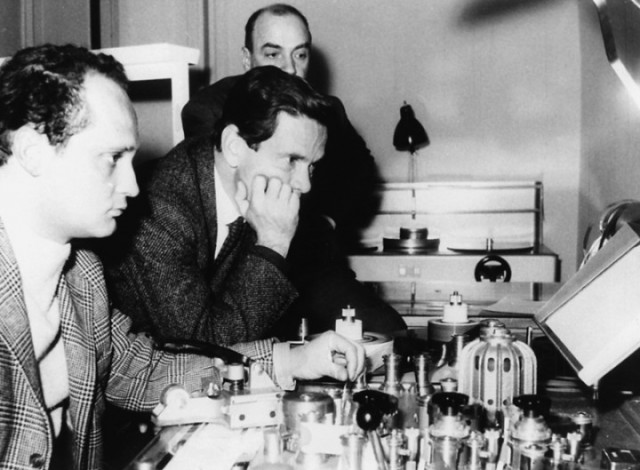
Nino Baragli, Pier Paolo Pasolini, and Gastone Ferranti edit the controversial sociopolitical documentary LA RABBIA
LA RABBIA DI PASOLINI (THE ANGER OF PASOLINI) (Pier Paolo Pasolini, 1963)
MoMA Film, Museum of Modern Art
11 West 53rd St. between Fifth & Sixth Aves.
Wednesday, December 26, 4:30
Series runs through January 5
Tickets: $12, in person only, may be applied to museum admission within thirty days, same-day screenings free with museum admission, available at Film and Media Desk beginning at 9:30 am
212-708-9400
www.moma.org
 In 1963, producer Gastone Ferranti asked Italian director Pier Paolo Pasolini to make a leftist political documentary about the postwar situation utilizing the producer’s large collection of Mondo Libero newsreel footage, answering the question “Why is our life dominated by discontent, by anguish, by the fear of war, by war?” Not thrilled with the result, he chopped Pasolini’s film in half and hired right-wing demagogue Giovanni Guareschi to create a conservative documentary providing an opposing viewpoint. La rabbia, or The Anger, opened in theaters in Italy and was quickly pulled from release, essentially disappearing until 2005, when a complete color negative was discovered and the two parts were restored and brought back together in a deluxe DVD package. La rabbia di Pasolini (The Anger of Pasolini), which is screening with the amazing La ricotta on December 26 at 4:30 as part of MoMA’s Pasolini career retrospective, is a curious examination of the state of the world. “My idea was to offer a Marxist denunciation of the society and events of the time,” Pasolini explained. Over the course of fifty-four minutes, he and editor Nino Baragli (with Giuseppe Bertolucci handling the recent reconstruction) create a cinematic collage of religion, communism, fascism, socialism, poverty, hunger, colonialism, race, and war through footage of the Hungary revolts of 1956, protests in Rome and Madrid, the war in Algeria, the coronation of Queen Elizabeth II, the rise of Patrice Lumumba in the Belgian Congo, and clips of such other international figures as Lenin, Stalin, Pope John XXIII, Sukarno, Nasser, de Gaulle, Eisenhower, Khrushchev, Yuri Gagarin, and even Marilyn Monroe as he poetically laments about life in the twentieth century. “People of color, it is in hope that man has no color,” one of his narrators says in the film. (The text is recited by actor Giorgio Bassani and painter Renato Guttuso; works by the latter are included in the documentary, along with pieces by Ben Shahn, Jean Fautrier, and George Grosz.) “Long live freedom,” the film repeats, but there’s not much promise for the future.
In 1963, producer Gastone Ferranti asked Italian director Pier Paolo Pasolini to make a leftist political documentary about the postwar situation utilizing the producer’s large collection of Mondo Libero newsreel footage, answering the question “Why is our life dominated by discontent, by anguish, by the fear of war, by war?” Not thrilled with the result, he chopped Pasolini’s film in half and hired right-wing demagogue Giovanni Guareschi to create a conservative documentary providing an opposing viewpoint. La rabbia, or The Anger, opened in theaters in Italy and was quickly pulled from release, essentially disappearing until 2005, when a complete color negative was discovered and the two parts were restored and brought back together in a deluxe DVD package. La rabbia di Pasolini (The Anger of Pasolini), which is screening with the amazing La ricotta on December 26 at 4:30 as part of MoMA’s Pasolini career retrospective, is a curious examination of the state of the world. “My idea was to offer a Marxist denunciation of the society and events of the time,” Pasolini explained. Over the course of fifty-four minutes, he and editor Nino Baragli (with Giuseppe Bertolucci handling the recent reconstruction) create a cinematic collage of religion, communism, fascism, socialism, poverty, hunger, colonialism, race, and war through footage of the Hungary revolts of 1956, protests in Rome and Madrid, the war in Algeria, the coronation of Queen Elizabeth II, the rise of Patrice Lumumba in the Belgian Congo, and clips of such other international figures as Lenin, Stalin, Pope John XXIII, Sukarno, Nasser, de Gaulle, Eisenhower, Khrushchev, Yuri Gagarin, and even Marilyn Monroe as he poetically laments about life in the twentieth century. “People of color, it is in hope that man has no color,” one of his narrators says in the film. (The text is recited by actor Giorgio Bassani and painter Renato Guttuso; works by the latter are included in the documentary, along with pieces by Ben Shahn, Jean Fautrier, and George Grosz.) “Long live freedom,” the film repeats, but there’s not much promise for the future.
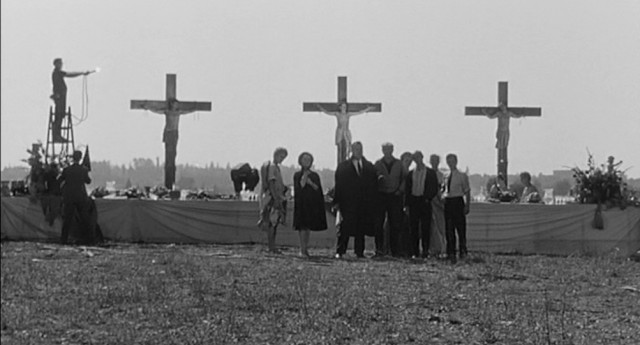
Pasolini examines the Passion of the Christ and social and religious conditions in Italy in riotous satire LA RICOTTA
LA RICOTTA (Pier Paolo Pasolini, 1962-63)
MoMA Film, Museum of Modern Art
11 West 53rd St. between Fifth & Sixth Aves.
Wednesday, December 26, 4:30
Series runs through January 5
Tickets: $12, in person only, may be applied to museum admission within thirty days, same-day screenings free with museum admission, available at Film and Media Desk beginning at 9:30 am
212-708-9400
www.moma.org
 In 1962, producer Alfredo Bini invited Pier Paolo Pasolini to participate in an omnibus film featuring four shorts, which came to be known as Ro.Go.Pa.G. for the four directors involved, Roberto Rossellini (llibatezza), Jean-Luc Godard (Il Nuovo Mondo), Pasolini, and Ugo Gregoretti (Il Pollo Ruspante). Pasolini contributed the mini-masterpiece La ricotta, a marvelously entertaining satire set around the making of a film about the Passion of the Christ. Mario Cipriani stars as Givoanni Stracci (“Joe Rags”), a goofy, very hungry man who is playing the role of the good thief in the film within a film. As the put-upon Stracci desperately tries to feed his family and get a bite to eat for himself, the director, played by Orson Welles (dubbed by La rabbia narrator Gregorio Bassani), has to deal with a pampered lead actress (Laura Betti), a crew that keeps playing hip 1960s cha-cha music instead of the intended classical score by Scarlatti (Carlo Rustichelli’s soundtrack is mind-blowingly magnificent), and a nosy reporter (Vittorio La Paglia) who wants an interview — which turns into a riotous segment with Welles quoting from Pasolini’s Mamma Roma book. “What do you think of Italian society?” the reporter asks. “The most illiterate masses and the most ignorant bourgeoisie in Europe,” the director replies. Pasolini fills La ricotta with inside jokes, social commentary, and wry humor while he and cinematographer Tonino Delli Colli go from Technicolor biblical epic to black-and-white neo-Realist melodrama to speeded-up Hollywood slapstick comedy. In the film’s introduction, Pasolini says, “I want to state here and now that however La ricotta is taken, the story of the passion, which La ricotta indirectly recalls, is for me the greatest event that has ever happened.” That didn’t stop the government from arresting Pasolini upon the film’s release, charging him with “insulting the religion of the state,” and sentencing him to four months in prison, a verdict that was later overturned on appeal. A small classic that has to be seen to be believed, La ricotta is screening on December 26 as part of a double feature with La rabbia di Pasolini as MoMA’s tribute to the Italian genius continues.
In 1962, producer Alfredo Bini invited Pier Paolo Pasolini to participate in an omnibus film featuring four shorts, which came to be known as Ro.Go.Pa.G. for the four directors involved, Roberto Rossellini (llibatezza), Jean-Luc Godard (Il Nuovo Mondo), Pasolini, and Ugo Gregoretti (Il Pollo Ruspante). Pasolini contributed the mini-masterpiece La ricotta, a marvelously entertaining satire set around the making of a film about the Passion of the Christ. Mario Cipriani stars as Givoanni Stracci (“Joe Rags”), a goofy, very hungry man who is playing the role of the good thief in the film within a film. As the put-upon Stracci desperately tries to feed his family and get a bite to eat for himself, the director, played by Orson Welles (dubbed by La rabbia narrator Gregorio Bassani), has to deal with a pampered lead actress (Laura Betti), a crew that keeps playing hip 1960s cha-cha music instead of the intended classical score by Scarlatti (Carlo Rustichelli’s soundtrack is mind-blowingly magnificent), and a nosy reporter (Vittorio La Paglia) who wants an interview — which turns into a riotous segment with Welles quoting from Pasolini’s Mamma Roma book. “What do you think of Italian society?” the reporter asks. “The most illiterate masses and the most ignorant bourgeoisie in Europe,” the director replies. Pasolini fills La ricotta with inside jokes, social commentary, and wry humor while he and cinematographer Tonino Delli Colli go from Technicolor biblical epic to black-and-white neo-Realist melodrama to speeded-up Hollywood slapstick comedy. In the film’s introduction, Pasolini says, “I want to state here and now that however La ricotta is taken, the story of the passion, which La ricotta indirectly recalls, is for me the greatest event that has ever happened.” That didn’t stop the government from arresting Pasolini upon the film’s release, charging him with “insulting the religion of the state,” and sentencing him to four months in prison, a verdict that was later overturned on appeal. A small classic that has to be seen to be believed, La ricotta is screening on December 26 as part of a double feature with La rabbia di Pasolini as MoMA’s tribute to the Italian genius continues.
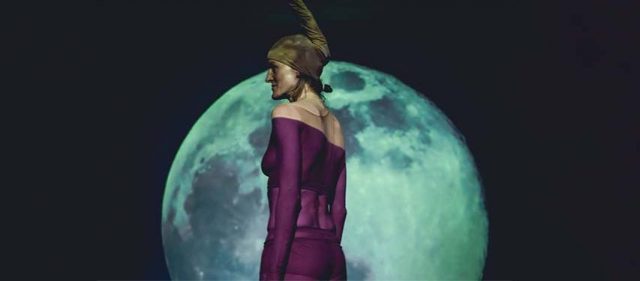
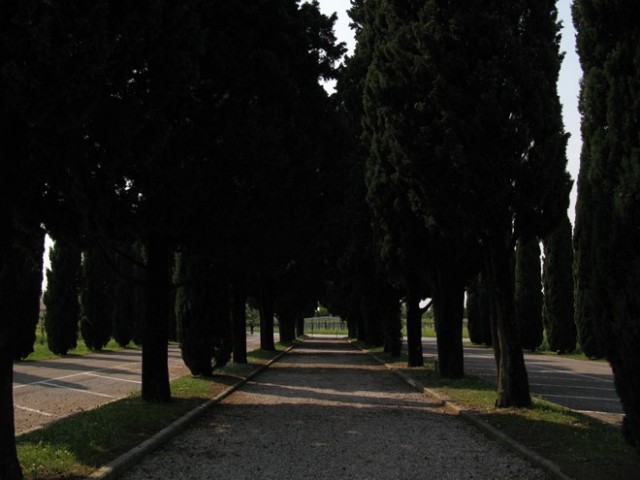
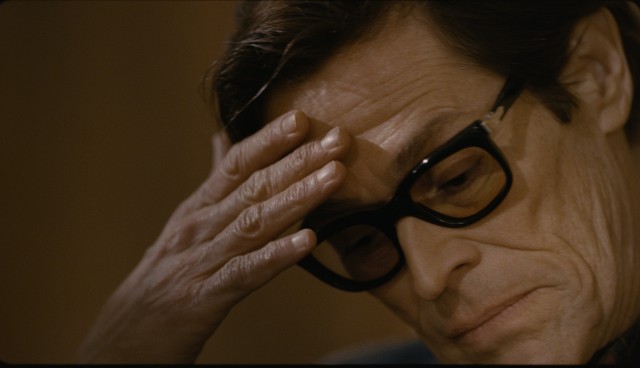
 Director Abel Ferrara packs a whole lot into controversial Italian writer and filmmaker Pier Paolo Pasolini’s last day on earth in the multinational coproduction Pasolini. Unfortunately, it all ends up a rather confusing jumble, with Ferrara (Bad Lieutenant, The Addiction) and screenwriter Maurizio Braucci (Gomorrah, Black Souls) squeezing too much into too little. Willem Dafoe stars as Pasolini on November 2, 1975, as the director is interviewed by a journalist, reads the newspaper on the couch, sits down at his typewriter to work on his novel Petrolio, edits what would be his final film (Salò, or the 120 Days of Sodom), and goes cruising to pick up a young stud. Ferrara adds enactments of scenes from the never-realized Porno-Teo-Kolossal, with Pasolini’s real-life lover, Ninetto Davoli, playing the fictional character Epifanio. (Davoli was supposed to play the younger Nunzio in the hallucinatory tale, about a search for faith and the messiah. Davoli is played by Riccardo Scamarcio in Ferrara’s film.) Ferrara never really delves into the internal makeup of Pasolini (The Gospel According to Matthew, Teorema), an openly gay outspoken social and political activist, poet, Marxist, Christian, and documentarian, instead using brief episodes that only touch the surface, as if Dafoe is playing a character based on Pasolini rather than the complex man who was indeed Pasolini. But Ferrara does get very specific about Pasolini’s mysterious, brutal death. Pasolini is screening October 2, 3, and 12 at the 52nd New York Film Festival.
Director Abel Ferrara packs a whole lot into controversial Italian writer and filmmaker Pier Paolo Pasolini’s last day on earth in the multinational coproduction Pasolini. Unfortunately, it all ends up a rather confusing jumble, with Ferrara (Bad Lieutenant, The Addiction) and screenwriter Maurizio Braucci (Gomorrah, Black Souls) squeezing too much into too little. Willem Dafoe stars as Pasolini on November 2, 1975, as the director is interviewed by a journalist, reads the newspaper on the couch, sits down at his typewriter to work on his novel Petrolio, edits what would be his final film (Salò, or the 120 Days of Sodom), and goes cruising to pick up a young stud. Ferrara adds enactments of scenes from the never-realized Porno-Teo-Kolossal, with Pasolini’s real-life lover, Ninetto Davoli, playing the fictional character Epifanio. (Davoli was supposed to play the younger Nunzio in the hallucinatory tale, about a search for faith and the messiah. Davoli is played by Riccardo Scamarcio in Ferrara’s film.) Ferrara never really delves into the internal makeup of Pasolini (The Gospel According to Matthew, Teorema), an openly gay outspoken social and political activist, poet, Marxist, Christian, and documentarian, instead using brief episodes that only touch the surface, as if Dafoe is playing a character based on Pasolini rather than the complex man who was indeed Pasolini. But Ferrara does get very specific about Pasolini’s mysterious, brutal death. Pasolini is screening October 2, 3, and 12 at the 52nd New York Film Festival.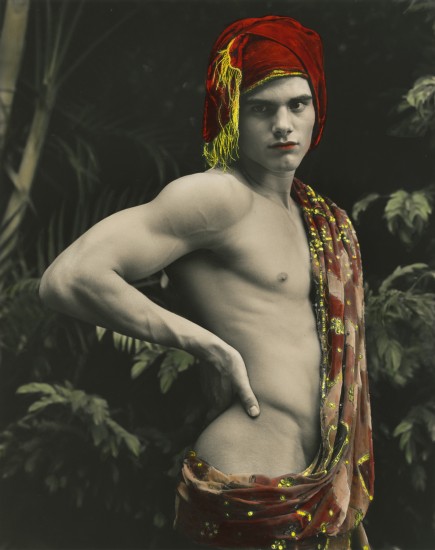
 Fashion photographer Bruce Weber, who directed the seminal Chet Baker doc Let’s Get Lost a quarter century ago, made this fun hodgepodge of still photos, old color and black-and-white footage, and new interviews and voice-over narration back in 2001. You might not know much about Frances Faye, but after seeing her perform in vintage Ed Sullivan clips and listening to her manager/longtime partner discuss their life together, you’ll be searching YouTube to check out a lot more. The film also examines how Weber selects and treats his male models, who are often shot in homoerotic poses for major designers (and later go on to get married and have children). As a special treat, Jan-Michael Vincent’s extensive full-frontal nude scene in Daniel Petrie and Sidney Sheldon’s 1974 Buster and Billie is on display here, as are vintage clips of Sammy Davis Jr., adventurer Sir Wilfred Thesiger, former Vogue editor Diana Vreeland, and Robert Mitchum singing in a recording studio with Dr. John. The film is about model Peter Johnson and Weber as much as it is about the cult of celebrity; Weber gets to chime in on Elizabeth Taylor, Montgomery Clift, Clark Gable, Frank Sinatra, Arthur Miller, and dozens of other famous names and faces. Though an awful lot of fun, the film is disjointed, lacking a central focus, and the onscreen titles, end credits, and promotional postcards are chock-full of typos — perhaps emulating a Chinese takeout menu, hence the film’s title? Chop Suey is screening November 20 at 7:00 as part of Film Forum’s “Bruce Weber” series and will be preceded by Weber’s twelve-minute 2008 short, The Boy Artist; the series continues through November 21 with a 35mm print of Let’s Get Lost, 1987’s Broken Noses, about former Olympian boxer Andy Minsker, 2004’s A Letter to True, a tribute to Weber’s dog, and a compilation of shorts, videos, commercials, and works in progress.
Fashion photographer Bruce Weber, who directed the seminal Chet Baker doc Let’s Get Lost a quarter century ago, made this fun hodgepodge of still photos, old color and black-and-white footage, and new interviews and voice-over narration back in 2001. You might not know much about Frances Faye, but after seeing her perform in vintage Ed Sullivan clips and listening to her manager/longtime partner discuss their life together, you’ll be searching YouTube to check out a lot more. The film also examines how Weber selects and treats his male models, who are often shot in homoerotic poses for major designers (and later go on to get married and have children). As a special treat, Jan-Michael Vincent’s extensive full-frontal nude scene in Daniel Petrie and Sidney Sheldon’s 1974 Buster and Billie is on display here, as are vintage clips of Sammy Davis Jr., adventurer Sir Wilfred Thesiger, former Vogue editor Diana Vreeland, and Robert Mitchum singing in a recording studio with Dr. John. The film is about model Peter Johnson and Weber as much as it is about the cult of celebrity; Weber gets to chime in on Elizabeth Taylor, Montgomery Clift, Clark Gable, Frank Sinatra, Arthur Miller, and dozens of other famous names and faces. Though an awful lot of fun, the film is disjointed, lacking a central focus, and the onscreen titles, end credits, and promotional postcards are chock-full of typos — perhaps emulating a Chinese takeout menu, hence the film’s title? Chop Suey is screening November 20 at 7:00 as part of Film Forum’s “Bruce Weber” series and will be preceded by Weber’s twelve-minute 2008 short, The Boy Artist; the series continues through November 21 with a 35mm print of Let’s Get Lost, 1987’s Broken Noses, about former Olympian boxer Andy Minsker, 2004’s A Letter to True, a tribute to Weber’s dog, and a compilation of shorts, videos, commercials, and works in progress.

 In 1962, producer Alfredo Bini invited Pier Paolo Pasolini to participate in an omnibus film featuring four shorts, which came to be known as Ro.Go.Pa.G. for the four directors involved, Roberto Rossellini (llibatezza), Jean-Luc Godard (Il Nuovo Mondo), Pasolini, and Ugo Gregoretti (Il Pollo Ruspante). Pasolini contributed the mini-masterpiece La ricotta, a marvelously entertaining satire set around the making of a film about the Passion of the Christ. Mario Cipriani stars as Givoanni Stracci (“Joe Rags”), a goofy, very hungry man who is playing the role of the good thief in the film within a film. As the put-upon Stracci desperately tries to feed his family and get a bite to eat for himself, the director, played by Orson Welles (dubbed by La rabbia narrator Gregorio Bassani), has to deal with a pampered lead actress (Laura Betti), a crew that keeps playing hip 1960s cha-cha music instead of the intended classical score by Scarlatti (Carlo Rustichelli’s soundtrack is mind-blowingly magnificent), and a nosy reporter (Vittorio La Paglia) who wants an interview — which turns into a riotous segment with Welles quoting from Pasolini’s Mamma Roma book. “What do you think of Italian society?” the reporter asks. “The most illiterate masses and the most ignorant bourgeoisie in Europe,” the director replies. Pasolini fills La ricotta with inside jokes, social commentary, and wry humor while he and cinematographer Tonino Delli Colli go from Technicolor biblical epic to black-and-white neo-Realist melodrama to speeded-up Hollywood slapstick comedy. In the film’s introduction, Pasolini says, “I want to state here and now that however La ricotta is taken, the story of the passion, which La ricotta indirectly recalls, is for me the greatest event that has ever happened.” That didn’t stop the government from arresting Pasolini upon the film’s release, charging him with “insulting the religion of the state,” and sentencing him to four months in prison, a verdict that was later overturned on appeal. A small classic that has to be seen to be believed, La ricotta is screening on December 26 as part of a double feature with La rabbia di Pasolini as MoMA’s tribute to the Italian genius continues.
In 1962, producer Alfredo Bini invited Pier Paolo Pasolini to participate in an omnibus film featuring four shorts, which came to be known as Ro.Go.Pa.G. for the four directors involved, Roberto Rossellini (llibatezza), Jean-Luc Godard (Il Nuovo Mondo), Pasolini, and Ugo Gregoretti (Il Pollo Ruspante). Pasolini contributed the mini-masterpiece La ricotta, a marvelously entertaining satire set around the making of a film about the Passion of the Christ. Mario Cipriani stars as Givoanni Stracci (“Joe Rags”), a goofy, very hungry man who is playing the role of the good thief in the film within a film. As the put-upon Stracci desperately tries to feed his family and get a bite to eat for himself, the director, played by Orson Welles (dubbed by La rabbia narrator Gregorio Bassani), has to deal with a pampered lead actress (Laura Betti), a crew that keeps playing hip 1960s cha-cha music instead of the intended classical score by Scarlatti (Carlo Rustichelli’s soundtrack is mind-blowingly magnificent), and a nosy reporter (Vittorio La Paglia) who wants an interview — which turns into a riotous segment with Welles quoting from Pasolini’s Mamma Roma book. “What do you think of Italian society?” the reporter asks. “The most illiterate masses and the most ignorant bourgeoisie in Europe,” the director replies. Pasolini fills La ricotta with inside jokes, social commentary, and wry humor while he and cinematographer Tonino Delli Colli go from Technicolor biblical epic to black-and-white neo-Realist melodrama to speeded-up Hollywood slapstick comedy. In the film’s introduction, Pasolini says, “I want to state here and now that however La ricotta is taken, the story of the passion, which La ricotta indirectly recalls, is for me the greatest event that has ever happened.” That didn’t stop the government from arresting Pasolini upon the film’s release, charging him with “insulting the religion of the state,” and sentencing him to four months in prison, a verdict that was later overturned on appeal. A small classic that has to be seen to be believed, La ricotta is screening on December 26 as part of a double feature with La rabbia di Pasolini as MoMA’s tribute to the Italian genius continues.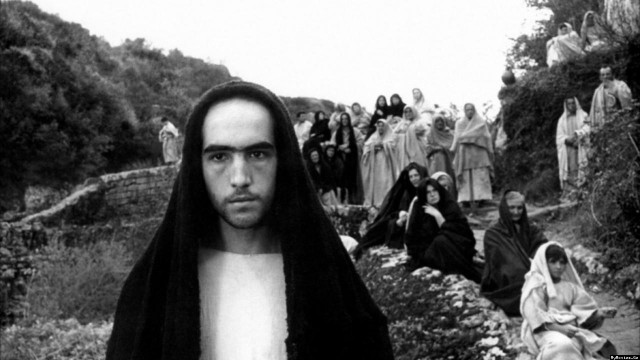
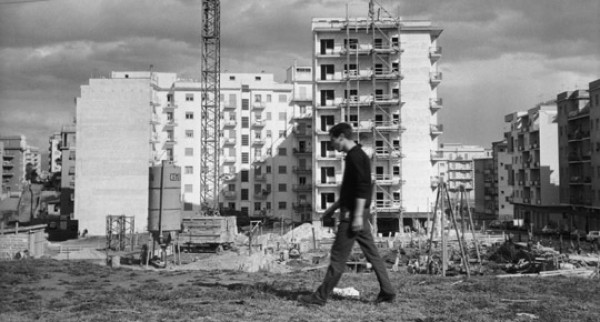
 After collaborating on a number of works by such auteurs as Mauro Bolognini and Federico Fellini, poet and novelist Pier Paolo Pasolini made his directorial debut in 1961 with the gritty, not-quite-neo-realist Accattone (“scrounger” or “beggar”). Somewhat related to his books Ragazzi di vita and Una vita violenta, the film is set in the Roman borgate, where brash young Vittorio “Accattone” Cataldi (Franco Citti) survives by taking crazy bets — like swimming across a river known for swallowing up people’s lives — and working as a pimp. After a group of local men beat up his main money maker (Silvana Corsini), he meets the more naive Stella (Franca Pasut), whom he starts dating with an eye toward perhaps converting into a prostitute as well. Meanwhile, he tries to establish a relationship with his son, but his estranged wife and her family want nothing to do with him. Filmed in black-and-white by master cinematographer Tonino Delli Colli, Accattone is highlighted by a series of memorable shots, from Accattone’s gorgeous dive from a bridge to a close-up of his face covered in sand, many of which were inspired by Baroque art and set to music by Bach. Written with Sergio Citti and featuring a production assistant named Bernardo Bertolucci, the story delves into the dire poverty in the slums of Rome, made all the more real by Pasolini’s use of both professional and nonprofessional actors. Accattone is screening December 14 and 27 as part of MoMA’s “Pier Paolo Pasolini” series, a full career retrospective that runs December 13 to January 5 and includes such special events as “Recital: An Evening Dedicated to Pier Paolo Pasolini the Poet” at MoMA on December 14 and the Sunday Sessions program “Pier Paolo Pasolini: Intellettuale” at MoMA PS1 on December 16 with Paul Chan, Ninetto Davoli, Emi Fontana, Barbara Hammer, Alfredo Jaar, Lovett/Codagnone, and Fabio Mauri. In addition, there will be a number of other Pasolini celebrations around the city, including the December 13 seminar “Pasolini’s Languages” at the
After collaborating on a number of works by such auteurs as Mauro Bolognini and Federico Fellini, poet and novelist Pier Paolo Pasolini made his directorial debut in 1961 with the gritty, not-quite-neo-realist Accattone (“scrounger” or “beggar”). Somewhat related to his books Ragazzi di vita and Una vita violenta, the film is set in the Roman borgate, where brash young Vittorio “Accattone” Cataldi (Franco Citti) survives by taking crazy bets — like swimming across a river known for swallowing up people’s lives — and working as a pimp. After a group of local men beat up his main money maker (Silvana Corsini), he meets the more naive Stella (Franca Pasut), whom he starts dating with an eye toward perhaps converting into a prostitute as well. Meanwhile, he tries to establish a relationship with his son, but his estranged wife and her family want nothing to do with him. Filmed in black-and-white by master cinematographer Tonino Delli Colli, Accattone is highlighted by a series of memorable shots, from Accattone’s gorgeous dive from a bridge to a close-up of his face covered in sand, many of which were inspired by Baroque art and set to music by Bach. Written with Sergio Citti and featuring a production assistant named Bernardo Bertolucci, the story delves into the dire poverty in the slums of Rome, made all the more real by Pasolini’s use of both professional and nonprofessional actors. Accattone is screening December 14 and 27 as part of MoMA’s “Pier Paolo Pasolini” series, a full career retrospective that runs December 13 to January 5 and includes such special events as “Recital: An Evening Dedicated to Pier Paolo Pasolini the Poet” at MoMA on December 14 and the Sunday Sessions program “Pier Paolo Pasolini: Intellettuale” at MoMA PS1 on December 16 with Paul Chan, Ninetto Davoli, Emi Fontana, Barbara Hammer, Alfredo Jaar, Lovett/Codagnone, and Fabio Mauri. In addition, there will be a number of other Pasolini celebrations around the city, including the December 13 seminar “Pasolini’s Languages” at the